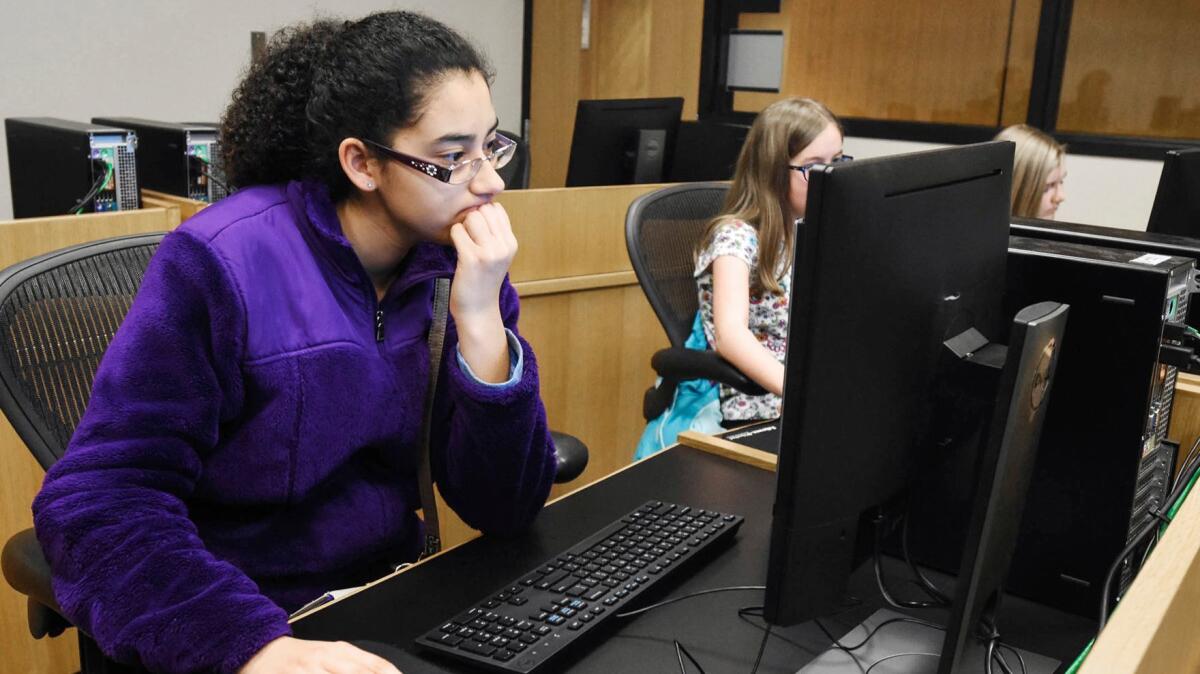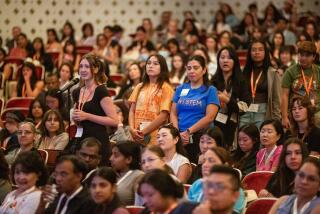Op-Ed: The gender gap in tech isn’t set in stone

- Share via
It is often said that women are absent from the sciences. But this is not true. Not anymore. Although a gender gap remains in the sciences overall, the gap is closing. Women are now more likely than men to earn undergraduate degrees in biology, and they are almost as likely as men to earn undergraduate degrees in chemistry and math.
There are, however, several scientific disciplines that women are still much less likely than men to choose to study: computer science, engineering and physics.
Our new research suggests that there is at least one important reason for this — and it is not because differences between men and women in computer science are set in stone, as a certain former Google engineer’s controversial memo would have us believe.
Rather, we found that, from a young age, American children form the belief that boys are better than girls in these technological subjects. This specific stereotype shows up even earlier than gendered ideas about math and science more broadly.
Parents can play an instrumental role in inspiring girls to consider a future in computer science and engineering.
We asked a group of 96 first-grade children whether boys or girls were better at robotics, programming, math and science. Across both genders, a majority of the children, all of whom were 6 years old, reported that they believed boys were better than girls at robotics and programming. The children did not report this same bias when asked which gender was better at math and science.
We also found that the stronger the girls’ gender stereotypes about robotics and programming, the less they believed that they themselves were skilled at these activities.
To find out whether we could get girls to express interest in computer science and engineering despite this stereotype, we conducted a more direct experiment.
We gave 32 of the 6-year-old girls and boys a robot pet to program for 20 minutes using a mobile phone app. The remaining 64 girls and boys either played a storytelling game or did no activity at all.
Afterward, we asked all the children how interested they were in robotics and programming, and also how good they were at these activities. Among the 64 children who did not get to program a robot, there was an observable gender gap: Boys reported greater interest in the activity, and confidence in their abilities, than the girls did.
But the girls who had played with the robot expressed more interest in robotics and programming and more confidence in their abilities. In fact, the gender gap in both interest and confidence completely disappeared among the children who had played with the robot.
The implications are clear: Gender gaps are malleable, not intrinsic. Experience and socialization matter.
The gender bias we found in first-graders is reflected in the enrollment statistics for classes in these subjects at American public high schools. Most students at public high schools in the U.S. will graduate without having taken a single computer science or engineering class. When such classes are offered, boys are more likely than girls to enroll.
When students haven’t had early experience with specific disciplines, they are likely to rely on stereotypes in order to decide whether to take classes in that subject. In previous research, we found that most high school students — girls and boys — associate computer science and engineering with geeky men. (Think TV’s “The Big Bang Theory.”) Because of this association, girls in American public high schools are less likely than boys to enroll in necessary “pipeline courses,” and are therefore also less likely to consider these professional fields. Quite simply, young girls and female students receive the message that they don’t belong.
Women’s representation in computer science hasn’t always been as low as it is now. In 1984, women earned almost 40% of undergraduate degrees in computer science. What happened? The personal computer revolution was marketed explicitly to boys, and computer science was linked in the popular imagination with males.
This trend can be reversed. Positive early experiences in scientific disciplines can counteract the negative effects of these gender stereotypes. In particular, parents can play an instrumental role in inspiring girls to consider a future in computer science and engineering.
Although they are hard to find in toy-store aisles, gender-neutral mechanical toys are a good place to start. One of us recently gave an electronics kit to a friend’s 7-year-old daughter as a birthday gift. The kit, which allows kids to make doorbells, radios and alarms using colorful circuits that snap together, became one of the girl’s favorite toys. She liked it so much, in fact, that she asked her parents if she could enroll in a robotics camp.
Sapna Cheryan is an associate professor of psychology at the University of Washington. Allison Master is a research scientist at the Institute for Learning and Brain Sciences at the University of Washington. Andrew N. Meltzoff is a professor of psychology and a co-director of the Institute for Learning and Brain Sciences at the University of Washington.
Follow the Opinion section on Twitter @latimesopinion or Facebook
More to Read
A cure for the common opinion
Get thought-provoking perspectives with our weekly newsletter.
You may occasionally receive promotional content from the Los Angeles Times.










